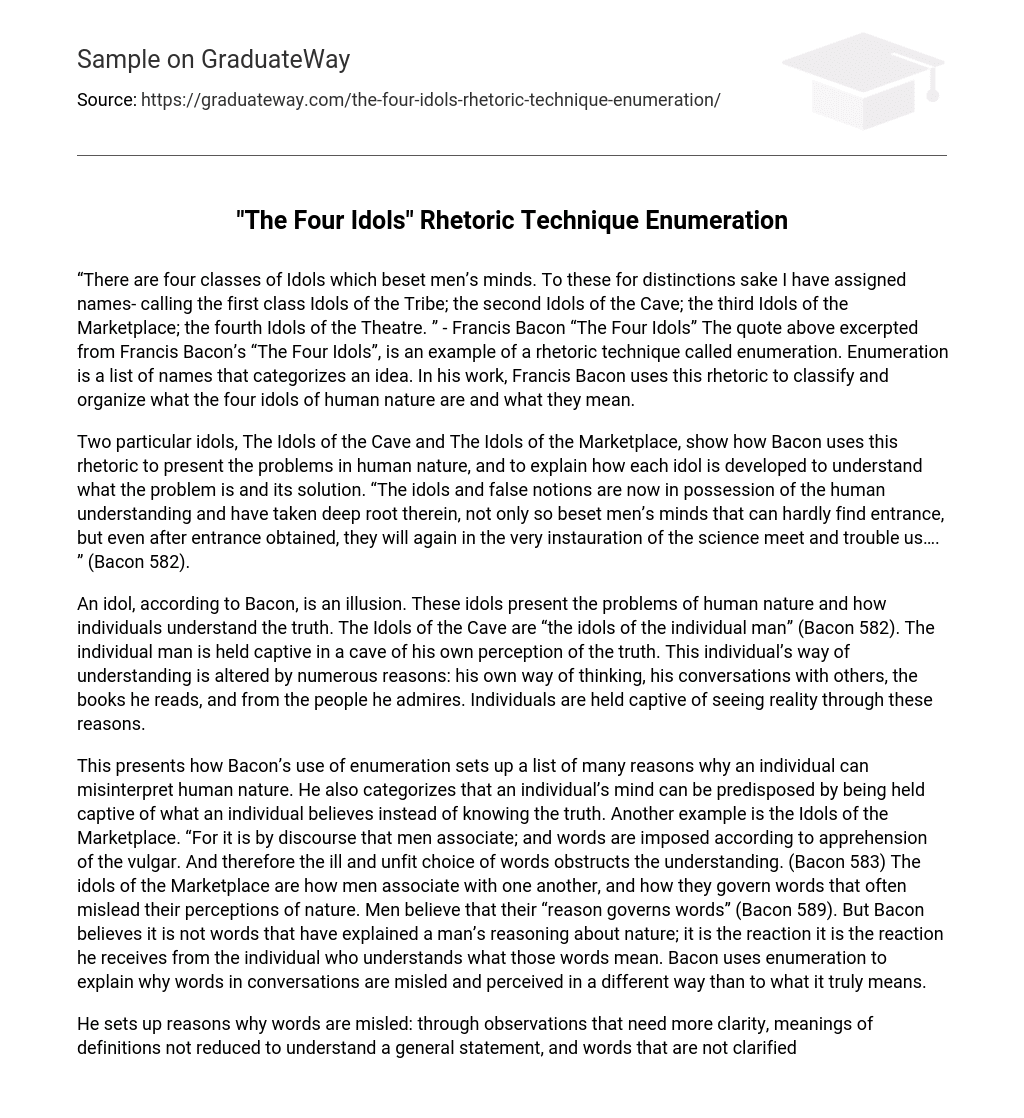“There are four classes of Idols which beset men’s minds. To these for distinctions sake I have assigned names- calling the first class Idols of the Tribe; the second Idols of the Cave; the third Idols of the Marketplace; the fourth Idols of the Theatre. ” – Francis Bacon “The Four Idols” The quote above excerpted from Francis Bacon’s “The Four Idols”, is an example of a rhetoric technique called enumeration. Enumeration is a list of names that categorizes an idea. In his work, Francis Bacon uses this rhetoric to classify and organize what the four idols of human nature are and what they mean.
Two particular idols, The Idols of the Cave and The Idols of the Marketplace, show how Bacon uses this rhetoric to present the problems in human nature, and to explain how each idol is developed to understand what the problem is and its solution. “The idols and false notions are now in possession of the human understanding and have taken deep root therein, not only so beset men’s minds that can hardly find entrance, but even after entrance obtained, they will again in the very instauration of the science meet and trouble us…. ” (Bacon 582).
An idol, according to Bacon, is an illusion. These idols present the problems of human nature and how individuals understand the truth. The Idols of the Cave are “the idols of the individual man” (Bacon 582). The individual man is held captive in a cave of his own perception of the truth. This individual’s way of understanding is altered by numerous reasons: his own way of thinking, his conversations with others, the books he reads, and from the people he admires. Individuals are held captive of seeing reality through these reasons.
This presents how Bacon’s use of enumeration sets up a list of many reasons why an individual can misinterpret human nature. He also categorizes that an individual’s mind can be predisposed by being held captive of what an individual believes instead of knowing the truth. Another example is the Idols of the Marketplace. “For it is by discourse that men associate; and words are imposed according to apprehension of the vulgar. And therefore the ill and unfit choice of words obstructs the understanding. (Bacon 583) The idols of the Marketplace are how men associate with one another, and how they govern words that often mislead their perceptions of nature. Men believe that their “reason governs words” (Bacon 589). But Bacon believes it is not words that have explained a man’s reasoning about nature; it is the reaction it is the reaction he receives from the individual who understands what those words mean. Bacon uses enumeration to explain why words in conversations are misled and perceived in a different way than to what it truly means.
He sets up reasons why words are misled: through observations that need more clarity, meanings of definitions not reduced to understand a general statement, and words that are not clarified because they are not in order. Bacon states “words plainly force and overrule the understanding, and throw all into confusion and lead men away into numberless empty controversies and idle fantasies” (Bacon 583). This statement explains that words are categorized into definitions, spreading other words that need defining as well.
It causes a big confusion about human nature, for an individual needs an explanation of why those words in a conversation exist. The Idols of the Cave and the Idols of the Marketplace are examples of Bacon’s rhetoric technique. These idols are categorized and set up to explain an individual’s way of thinking and an individual’s way of speaking. Bacon’s use of this rhetoric is a good way of grasping the reader’s attention, and the reader understands Bacon’s scientific method of human nature clearly.
It proposes a problem, explains it by narrowing down why that problem exists, and gives a solution. For both idols, including the others, the solution is induction, which is gathering information that generalizes a specific thought. By generalizing thoughts an individual can understand more clearly the truth about human nature. WORKS CITED Francis Bacon. “The Four Idols. ” Trans. Francis Headlam and R. L. Ellis A World of Ideas. Ed. Lee A Jacobus. 8th ed. Boston: Bedford/ St. Martins 2010. 449-457. Print.





